Month:
February, 2008
Another One Bites the Dust…..
Notice: Use of undefined constant the_post_thumbnail - assumed 'the_post_thumbnail' in /home/netscrib/public_html/civilwarcavalry/wp-content/themes/wittenberg/archive.php on line 65

Chris Swift has deleted the content from his blog, and it’s gone. Consequently, I have deleted the link from my blogroll. And another one bites the dust…..
Scridb filterA Valid Question
Notice: Use of undefined constant the_post_thumbnail - assumed 'the_post_thumbnail' in /home/netscrib/public_html/civilwarcavalry/wp-content/themes/wittenberg/archive.php on line 65

Benjamin F. Cooling, who has written two very good books on Early’s Raid on Washington, left the following comment on my blog this morning:
Am curious – why do you think the project is worth doing – your seventeen page bibliography suggests that it has been done over and over and over. Even I am postholing Fort Stevens and a new biography of Wallace looms with Gary Gallagher presumably still working his Early biography. Fred Ray has done the sharpshooters, the Ohio 100 dayers story has been done. The arcane and obscure belong to the NPS on site for their interpretation and Ed Bearss gave them a good basis awhile ago – his flock publishing the government study. So, what gives with your curiosity?
While I think the tone of the question left a bit to be desired, it’s a valid question. Let me begin by saying that I completely understand being territorial about a topic, and Dr. Cooling has done a great deal of work on these topics. Consequently, I can appreciate his being territorial about it. Having said that, though, just because one has done work on a topic doesn’t make it one’s exclusive territory.
J. D. responded thusly:
Mr. Cooling,
Honored to hear from you! Well, to be quite honest, it’s often been said that Jeb Stuart’s ride to Gettysburg, and the retreat from Gettysburg, had been told and done to death.
Regardless, when we began gathering sources for each of those stories, they began to shape the events much more fully than before. In the event of Jeb’s ride, we began developing a perspective on his decision-making that hadn’t yet been explored. And previously there had been precious little ever put together on the fights at Fairfax Court House or the shelling of Carlisle. We discovered a good amount of material on the battle of Hanover that completely changed the interpretation of it. And a mountain of primary source never used in telling the fight at Hunterstown came to us. No book had ever fully told the story of the resulting controversy of Stuart’s ride and performance until our 3 chapters on the subject.
Our book on the Gettysburg Retreat developed the same way – Brown’s masterful study didn’t fully tell the story of the 22 fights and skirmishes from July 4 – 14, and no book yet fully explored Meade’s decision-making.
In the case of Jube’s Raid, we have combed all present and past works, including your own, and we determined to put our twist on it – telling the narrative in the context of all else that was taking place. There is yet much to be said about the Johnson-Gilmor Raid, and the fight at Ft. Stevens still hasn’t received a modern study. Judging by the amount of material we’ve gathered, we see the door open to tell this story just as we explored Jeb’s ride and the Gettysburg retreat. We are building on the wonderful work you and others have done, to lay the groundwork for such a study as ours.
I think I speak for Eric as well when I say we’d be honored if you would be involved as we work through the project, and give us your thoughts and critique as we get closer to putting it together.
Best regards,
J.D. Petruzzi
J.D.’s points are valid. Who says that more books about Pickett’s Charge are needed? But yet, they keep coming. The reason why is because the author obviously believes that he or she has something worthy of adding. Given the fact that there are very few campaigns or battles that have not been written about, using Dr. Cooling’s logic, no new Civil War books would ever be published. Clearly, that’s not the case.
We’re pursuing this project because we think we have something worthy to add. With all due respect to Dr. Cooling’s work, we’ve already turned up a number of sources that he never used–and which have never been used in any other published treatment of the battle–and those new sources add to and help to evolve the interpretation. Many of them deal with the stand by the 100 days men, and I disagree with Dr. Cooling’s assessment that what there is to be done with their fight has been written.
We’re likewise pursuing this project because we believe that we bring a certain amount of credibility to our tactical studies, and we believe that we can, and will, produce a book that will not only be different from Dr. Cooling’s but which will add to the body of knowledge by incorporating sources that he did not use. By just one example, we have located a set of papers formerly belonging to Lt. George Davis, of the 10th Vermont Infantry, who was awarded a Medal of Honor for his valor at Monocacy, that have never been used in any other published treatment of the battle by any other author. We will be using this material, which includes post-war correspondence with many officers engaged in the battle including brigade and division commanders.
Similarly, I have never seen any evidence that Davis’ Medal of Honor file from the National Archives has ever been used, or that the file of the other winner of the Medal (also from the 10th Vermont) has been used in any treatment of the battle. We’ve already made arrangements to obtain copies of those files, and will make use of them in our work.
Those are just a couple of examples. So, the answer is that while J. D. and I both have a great deal of respect for the work that Dr. Cooling has done in the past, he does not “own” this battle, and it does not mean that there isn’t room for a new and different treatment of these events.
And, to answer the question posed at the end of Dr. Cooling’s comment, I have maintained a fascination with these events since my first visit to the Monocacy battlefield in 1992 (and which prompted me to purchase Dr. Cooling’s first book on the raid since there was no interpretation on the battlefield other than the monuments placed by the veterans), and this project is a natural extension of that long-standing fascination.
Scridb filterWorking Title
Notice: Use of undefined constant the_post_thumbnail - assumed 'the_post_thumbnail' in /home/netscrib/public_html/civilwarcavalry/wp-content/themes/wittenberg/archive.php on line 65

On July 11, 1864, Confederate staff officer Charles Blackford wrote to his wife,
The sinking of the Alabama gives us great concern, and we are very anxious to hear from Early. I fear he has undertaken more than he can do with his small force, and he is likely to come to grief.”
From that, J. D. came up with a great title for our project, which I unveil here:
Likely to Come to Grief: Jubal Early’s Washington Raid, the Battle of Monocacy, the Johnson-Gilmor Raid, and the Fight at Fort Stevens
I like it.
Scridb filterWorking the Network….
Notice: Use of undefined constant the_post_thumbnail - assumed 'the_post_thumbnail' in /home/netscrib/public_html/civilwarcavalry/wp-content/themes/wittenberg/archive.php on line 65

J. D. and I have been working up an idea of what we’ve already got and what we need to obtain in order to feel like we’ve gotten what there is to have on Early’s 1864 raid on Washington. Between us, we already have quite a bit of information. However, the easiest way to keep track of what we’ve got and what we need is to maintain a working bibliography of the sources we’ve either already got, or want to get. Our working bibliography is already 17 single-spaced pages long so far, and there’s plenty more to go.
We’ve been working our network enlisting help where we can with tracking things down. Old friend Dave Powell sent along two excellent accounts, one from a trooper of the 8th Illinois Cavalry, and one from the 149th Ohio Infantry, one of the 100 days’ units. I’ve gotten some excellent newspaper accounts from the Macon, Georgia paper. Scott Patchan’s been particularly helpful. His excellent Shenandoah Summer: The 1864 Valley Campaign begins just after the events that we cover, so Scott’s work not only complements what we’re aiming to do, it also means that there are a lot of interchangeable sources, and Scott has been very generous about sharing them with us. There are lots of others who have been just as willing to help.
My point in raising all of this is that it never ceases to amaze me how helpful folks in this little Civil War community of ours are, and how freely they give of themselves when asked. Sure, we could find this stuff ourselves, but it would mean that the project would take a lot longer to complete, and we might miss things we otherwise wouldn’t have known about. I’ve said this many times: some of the very best people that I have ever met are folks that I’ve met as a direct result of my work with the Civil War, and the generosity of this community never ceases to amaze me.
I try to return the favor whenever and wherever I can, and have several different things that I’m reviewing for people in an effort to return some of that good karma.
Scridb filterKudos to Ebay
Notice: Use of undefined constant the_post_thumbnail - assumed 'the_post_thumbnail' in /home/netscrib/public_html/civilwarcavalry/wp-content/themes/wittenberg/archive.php on line 65

On January 29, I reported on the arrest of Daniel Lorello, an archivist employed by the State of New York, who stole hundreds of documents and then sold many of them on eBay.
Then, J.D. Petruzzi reported that he had been contacted by the New York Attorney General’s office because he had apparently purchased a stolen document from Lorello on eBay. J.D. figured he was out the money, but he was ready to return the document to the archives, where it rightfully belongs.
Now, because eBay has decided to do the right thing, it looks like J. D. will get his money back.
EBay To Buy Back Stolen Historical Items, Michael Gormley, Associated Press, February 9, 2008.
Documents dating from the Civil War and others to and from Theodore and Franklin Roosevelt are among hundreds of stolen documents sold online that eBay is agreeing to buy back and return to New York’s archives, a state official said Saturday.
The online auction giant has no liability in the sale of the stolen artifacts, but agreed voluntarily to offer buyers the amount that they paid, according to the official who spoke on the condition of anonymity because not all details of the investigation have been announced. “We believe that when people realize they bought stolen artifacts they will step forward and do the right thing,” the state official said. The official said the buyers appear not to have known the documents were stolen and so wouldn’t face criminal charges. Cuomo and eBay will contact the buyers, the state official said.
In January, state Attorney General Andrew Cuomo’s investigation found that about 200 documents had been stolen from the archives and sold in the past two years. Checking through the buyer and seller comments in those eBay sales revealed that 200 other documents had been sold since 2001, according to the official. The total cost of buying back the documents for which eBay has sales records is estimated at $68,000. The offer by eBay means the state won’t have to spend money to buy the records. If there is a conviction, a court could order restitution. Usher Lieberman, an eBay spokesman, did not immediately respond to messages seeking comment.
In January, Cuomo charged Daniel Lorello, 54, an archives and records management specialist in the state Department of Education, with stealing items from the archives. Lorello, of Rensselaer near Albany, pleaded not guilty to charges of grand larceny, criminal possession of stolen property and scheme to defraud and was released awaiting trial. He faces up to 25 years in prison. Among the items stolen were Davy Crockett Almanacs—popular 19th century pamphlets about the frontier hero’s exploits—that sold for more than $5,000; artifacts associated with the Revolutionary, Civil and Mexican wars, black Americana and items related to both Roosevelts and to Jewish Americans.
The state was alerted to the theft and sales by a history buff, Virginia attorney Joseph Romito, who noticed the sale on eBay of a four-page letter by former Vice President John Calhoun that he knew belonged to the New York State Library and Archives. That letter was sold for $1,800.
I really respect that eBay is willing to do this, and I’m glad that no innocent purchaser who unwittingly bought one of these stolen documents from Lorello is going to end up taking a loss. That’s a great outcome, and perhaps it will assist in assuring that all of the stolen documents are returned to New York, where they belong.
Scridb filterOne day trip to Richmond, VA
Notice: Use of undefined constant the_post_thumbnail - assumed 'the_post_thumbnail' in /home/netscrib/public_html/civilwarcavalry/wp-content/themes/wittenberg/archive.php on line 65

Susan and I got up yesterday morning at the ungodly hour of 4:00 a.m. to catch a flight to Richmond. I was invited to be the speaker at the commemoration of the anniversary of Jeb Stuart’s birth by the Stuart-Mosby Historical Society. There was a commemoration at Stuart’s grave in Hollywood Cemetery, and then a luncheon at a lovely place called the Commonwealth Club. Susan did a good job of acting as photographer; these are her photos. Fortunately, it was 67 degrees in Richmond yesterday, and it was really nice being able to walk around without a coat in early February.
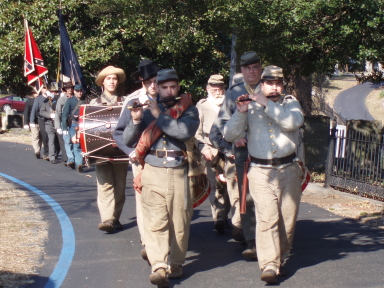
Detachments of two different reenacting groups provided honor guards. One was a fife and drum corps and the other a regimental color guard. Both were quite authentic, and both did a fine job.
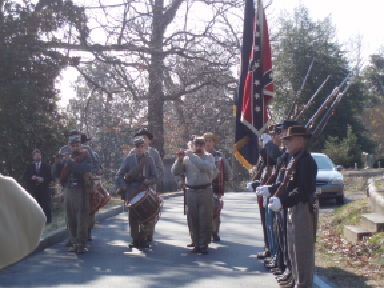
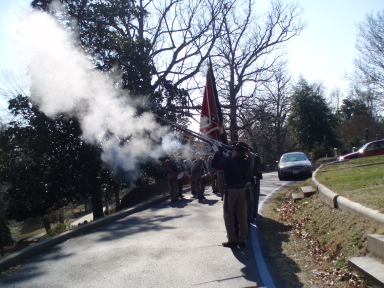
I’m told that there’s usually a cannon at the commemoration, but that they could not make it at the last moment. Instead, the color guard fired three volleys in General Stuart’s honor.
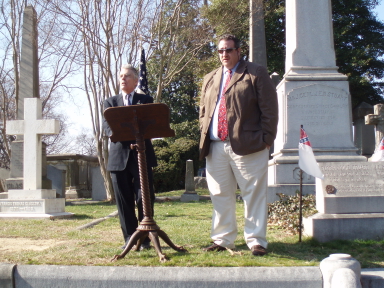
I found out yesterday morning that not only was I to speak at the luncheon after the graveside ceremony, I was also expected to say a few words at the cemetery. I had no idea of this until about twenty minutes before it happened, so I had to wing it. I guess I did okay.
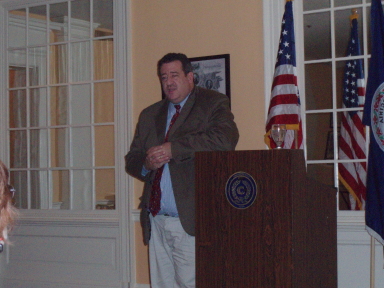
After a nice lunch, I gave the assembled members my rendition of the events covered in Plenty of Blame to Go Around: Jeb Stuart’s Controversial Ride to Gettysburg. I’m pretty sure I’m coming down with something, and my voice was pretty rough. I’m just glad it held out.
Last night, we had dinner at The Tobacco Company Restaurant in the Shockoe Slip district of Richmond with old friend Melissa Delcour, whom we haven’t seen in ages. We had a terrific dinner getting caught up with Melissa, and then it was to bed early to get up at 4:30 to make our return flight to Columbus this morning. We were gone for 26 hours, and it was chaotic. Thanks to Skybus, we were able to fly directly into Richmond for a very inexpensive airfare ($110 roundtrip for each of us) instead of all of that driving.
Needless to say, I’m not used to being up that early, let alone that early two days in a row. I suspect we’re all headed to bed early tonight……
Some Good Budgetary News for Gettysburg
Notice: Use of undefined constant the_post_thumbnail - assumed 'the_post_thumbnail' in /home/netscrib/public_html/civilwarcavalry/wp-content/themes/wittenberg/archive.php on line 65

For the first time in years, there is money in the Federal budget for land acquisition at Gettysburg. From today’s issue of The Hanover Evening Sun newspaper:
Battlefield bucks: Gettysburg Park could get $2.2M for expansion
By ERIN JAMES
Evening Sun Reporter
Article Launched: 02/06/2008 10:42:44 AM ESTFor the first time in eight years, the Gettysburg National Military Park could receive federal money to buy and preserve privately owned property within the park’s 6,000-acre boundary if the president’s 2009 budget for the country’s national parks is approved by Congress as it is proposed.
The budget is not yet law, but it includes $2.2 million for land acquisition within Gettysburg’s park.
The last time the Park Service received land-acquisition funds was in 2001, when the federal government committed more than $5.98 million.
Since that time, the Park Service has been under mounting pressure to preserve some of the remaining 20 percent of land within the park’s boundaries that is not already owned by the park, said spokeswoman Katie Lawhon.
“It’s been a concern for a long time,” she said.
Land-acquisition funds can be used to directly purchase privately owned property within the park from a willing seller or to purchase easements on privately owned land so that its owner cannot develop the property.
There are still 86 privately owned tracts – as large as 90 acres and as small as a half-acre – within the park’s boundaries. Some properties are used mainly for agricultural purposes while others are the sites of houses built in the 1960s or ’70s, Lawhon said.
The proposed budget also increases the park’s operating costs by $689,000 over the 2008 budget for operating costs, Lawhon said.
With that money, the park could begin to fill positions that have been vacant since funding was significantly decreased about 10 years ago, Lawhon said.
A 10.6-percent increase for operating costs in 2008 made it possible for the Park Service to fill seven of 16 vacancies. If the 2009 increase is approved, the park may be able to fill the remaining positions, she said.
“We’re starting to dig our way out of that hole,” she said.
About 90 percent of the park’s operating budget pays for the salaries of its employees, so a cut in operating funds translates into a cut in positions, Lawhon said.
Over the years, the park dealt with that problem by not replacing personnel who retired or left, she said.
“It would be completely random about which positions would become vacant,” she said.
The remaining vacant positions include two park rangers, two preservation workers, one human-resources assistant, two park guides and one tractor operator, she said.
The 2009 budget proposal was released to the public late Monday.
It also includes a $161 million increase in operating costs for national parks nationwide, according to a press release from the National Parks Conservation Association.
The advocacy group praised the increase but also criticized a funding cut to other park programs.
Lawhon said the Gettysburg park is “pleased” with the proposed budget but that the park would welcome even more of an increase.
“We still have some funding needs,” she said.
Contact Erin James at ejames@eveningsun.com.
HISTORY:
Land acquisition funds
1997: $0
1998: $2.95 million
1999: $1 million
2000: $1.6 million
2001: $5.98 million
2002: $0
2003: $0
2004: $0
2005: $0
2006: $0
2007: $0
2008: $0
2009: $2.2 million (proposed)
It’s not as much as I might hope for, but it certainly beats that big zero that we’ve had to live with for several years now.
Scridb filterOld Newspapers, Part 2
Notice: Use of undefined constant the_post_thumbnail - assumed 'the_post_thumbnail' in /home/netscrib/public_html/civilwarcavalry/wp-content/themes/wittenberg/archive.php on line 65

I’ve been spending a lot of time combing through old newspapers for material pertinent to our Monocacy, Fort Stevens, and Johnson-Gilmor Raid project. As I mentioned here the other day, I found a lot of good material at the Ohio Historical Society going through reels of microfilm.
Today, I spent a fair amount of this morning digging through on-line archives of Civil War-era newspapers, and I wanted to share those sites with you. There is a tremendous amount of material available for free, and anyone interested in doing this sort of research should be aware of what’s available.
First is the granddaddy of them all, the New York Times. Until last year, the Times charged for access to its archives. However, those archives are now available for free here. Every article back to 1851 is available for free here, in full text format, and fully searchable. Needless to say, there is quite literally a ton of great material available here.
Another very useful source is the Brooklyn Eagle. The Brooklyn Public Library has digitized every issue from 1841 through 1902, all of which are fully searchable and available for free here. The Eagle often contains very useful information, and I found a number of good articles there today.
Penn State University has digitized a number of Pennsylvania’s Civil War-era newspapers here. They include The Philadelphia Press, the Bellefonte Democratic Watchman, the Columbia Spy, the Franklin Repository of Chambersburg, the Erie Observer, the Gettysburg Compiler, the Huntingdon Globe, the Waynesboro Village Record, and the Wellsboro Agitator. I found a ton of really useful material in these papers today, none of which has ever been used in any other treatment of these events.
The Library of Congress has also begun a program to digitize American newspapers. These are less useful, though, because only those articles after 1900 are available, and only the newspapers from a handful of states are presently available. The Library of Congress intends to further expand the program, and then it will become a really useful tool.
NewspaperArchive.com is another very useful site, but it’s not one that I’ve used previously. It appears to be a pay-to-play site, so I’m going to have to determine whether it’s worth the expenditure. However, it has a very large collection of available obscure newspapers, and it looks very promising. I will have to spend some more time there, familiarizing myself with the online collection there before deciding whether to subscribe.
Scridb filterOld Newspapers
Notice: Use of undefined constant the_post_thumbnail - assumed 'the_post_thumbnail' in /home/netscrib/public_html/civilwarcavalry/wp-content/themes/wittenberg/archive.php on line 65

I spent much of the day going through reels of microfilm of old newspapers at the Ohio Historical Society today. Although OHS continues to be a whipping boy for the General Assembly whenever it needs a budget to slash, the OHS manages to struggle on, doing an excellent job with the outstanding collections it has. It has a truly impressive collection of Civil War newspapers on microfilm.
I’ve always enjoyed the accounts that can be found in newspapers. A lot of newspapers published soldier correspondence, and you can find great stuff there. Those accounts tend to be very reliable, because they were written contemporaneously and with the knowledge that the folks at home would be reading them. As just one example, today I found a letter by the colonel of the 149th Ohio Infantry, who made a stand at the stone bridge across the Monocacy River on the National Road. Brown’s letter, to his uncle, was written the day after the battle, and contains details I have never seen before anywhere else. It’s great stuff.
It’s also amusing to see some of the other stuff that can be found in those old papers. Lancaster, Ohio was William T. Sherman’s home town. The local newspaper, the Lancaster Eagle, was run by a major Copperhead sympathizer. The articles are very pro-Clement Vallandingham, and some of them contain some amazingly snarky commentary. The one that caught my eye today again had to do with Monocacy. It noted that Maj. Gen. Lew Wallace, who had been the Union commander at Monocacy, had been relieved of command of the Middle Military District. Indulging his inner snark, the author suggested that the reason why was because Wallace’s defeat at Monocacy had disturbed Henry W. Halleck’s nap time. I actually laughed out loud when I read that.
It seems that the more things change, the more they remain the same.
Scridb filterNotice: Undefined index: id in /home/netscrib/public_html/civilwarcavalry/wp-content/themes/wittenberg/footer.php on line 8
Notice: Undefined index: id in /home/netscrib/public_html/civilwarcavalry/wp-content/themes/wittenberg/footer.php on line 8
Notice: Undefined index: std in /home/netscrib/public_html/civilwarcavalry/wp-content/themes/wittenberg/footer.php on line 8
Notice: Undefined index: id in /home/netscrib/public_html/civilwarcavalry/wp-content/themes/wittenberg/footer.php on line 8
Notice: Undefined index: id in /home/netscrib/public_html/civilwarcavalry/wp-content/themes/wittenberg/footer.php on line 8
Notice: Undefined index: std in /home/netscrib/public_html/civilwarcavalry/wp-content/themes/wittenberg/footer.php on line 8
Notice: Undefined index: id in /home/netscrib/public_html/civilwarcavalry/wp-content/themes/wittenberg/footer.php on line 8
Notice: Undefined index: id in /home/netscrib/public_html/civilwarcavalry/wp-content/themes/wittenberg/footer.php on line 8
Notice: Undefined index: std in /home/netscrib/public_html/civilwarcavalry/wp-content/themes/wittenberg/footer.php on line 8
Notice: Undefined index: id in /home/netscrib/public_html/civilwarcavalry/wp-content/themes/wittenberg/footer.php on line 8
Notice: Undefined index: id in /home/netscrib/public_html/civilwarcavalry/wp-content/themes/wittenberg/footer.php on line 8
Notice: Undefined index: std in /home/netscrib/public_html/civilwarcavalry/wp-content/themes/wittenberg/footer.php on line 8
Notice: Undefined index: id in /home/netscrib/public_html/civilwarcavalry/wp-content/themes/wittenberg/footer.php on line 8
Notice: Undefined index: id in /home/netscrib/public_html/civilwarcavalry/wp-content/themes/wittenberg/footer.php on line 8
Notice: Undefined index: std in /home/netscrib/public_html/civilwarcavalry/wp-content/themes/wittenberg/footer.php on line 8
Notice: Undefined index: id in /home/netscrib/public_html/civilwarcavalry/wp-content/themes/wittenberg/footer.php on line 8
Notice: Undefined index: id in /home/netscrib/public_html/civilwarcavalry/wp-content/themes/wittenberg/footer.php on line 8
Notice: Undefined index: std in /home/netscrib/public_html/civilwarcavalry/wp-content/themes/wittenberg/footer.php on line 8
Notice: Undefined index: id in /home/netscrib/public_html/civilwarcavalry/wp-content/themes/wittenberg/footer.php on line 8
Notice: Undefined index: id in /home/netscrib/public_html/civilwarcavalry/wp-content/themes/wittenberg/footer.php on line 8
Notice: Undefined index: std in /home/netscrib/public_html/civilwarcavalry/wp-content/themes/wittenberg/footer.php on line 8
Notice: Undefined index: id in /home/netscrib/public_html/civilwarcavalry/wp-content/themes/wittenberg/footer.php on line 8
Notice: Undefined index: id in /home/netscrib/public_html/civilwarcavalry/wp-content/themes/wittenberg/footer.php on line 8
Notice: Undefined index: std in /home/netscrib/public_html/civilwarcavalry/wp-content/themes/wittenberg/footer.php on line 8
Notice: Undefined index: id in /home/netscrib/public_html/civilwarcavalry/wp-content/themes/wittenberg/footer.php on line 8
Notice: Undefined index: id in /home/netscrib/public_html/civilwarcavalry/wp-content/themes/wittenberg/footer.php on line 8
Notice: Undefined index: std in /home/netscrib/public_html/civilwarcavalry/wp-content/themes/wittenberg/footer.php on line 8
Notice: Undefined index: id in /home/netscrib/public_html/civilwarcavalry/wp-content/themes/wittenberg/footer.php on line 8
Notice: Undefined index: id in /home/netscrib/public_html/civilwarcavalry/wp-content/themes/wittenberg/footer.php on line 8
Notice: Undefined index: std in /home/netscrib/public_html/civilwarcavalry/wp-content/themes/wittenberg/footer.php on line 8
Notice: Undefined index: id in /home/netscrib/public_html/civilwarcavalry/wp-content/themes/wittenberg/footer.php on line 8
Notice: Undefined index: id in /home/netscrib/public_html/civilwarcavalry/wp-content/themes/wittenberg/footer.php on line 8
Notice: Undefined index: std in /home/netscrib/public_html/civilwarcavalry/wp-content/themes/wittenberg/footer.php on line 8
Notice: Undefined index: id in /home/netscrib/public_html/civilwarcavalry/wp-content/themes/wittenberg/footer.php on line 8
Notice: Undefined index: id in /home/netscrib/public_html/civilwarcavalry/wp-content/themes/wittenberg/footer.php on line 8
Notice: Undefined index: std in /home/netscrib/public_html/civilwarcavalry/wp-content/themes/wittenberg/footer.php on line 8
Notice: Undefined index: id in /home/netscrib/public_html/civilwarcavalry/wp-content/themes/wittenberg/footer.php on line 8
Notice: Undefined index: id in /home/netscrib/public_html/civilwarcavalry/wp-content/themes/wittenberg/footer.php on line 8
Notice: Undefined index: std in /home/netscrib/public_html/civilwarcavalry/wp-content/themes/wittenberg/footer.php on line 8
Notice: Undefined index: id in /home/netscrib/public_html/civilwarcavalry/wp-content/themes/wittenberg/footer.php on line 8
Notice: Undefined index: id in /home/netscrib/public_html/civilwarcavalry/wp-content/themes/wittenberg/footer.php on line 8
Notice: Undefined index: std in /home/netscrib/public_html/civilwarcavalry/wp-content/themes/wittenberg/footer.php on line 8
Notice: Undefined index: id in /home/netscrib/public_html/civilwarcavalry/wp-content/themes/wittenberg/footer.php on line 8
Notice: Undefined index: id in /home/netscrib/public_html/civilwarcavalry/wp-content/themes/wittenberg/footer.php on line 8
Notice: Undefined index: std in /home/netscrib/public_html/civilwarcavalry/wp-content/themes/wittenberg/footer.php on line 8
Notice: Undefined index: id in /home/netscrib/public_html/civilwarcavalry/wp-content/themes/wittenberg/footer.php on line 8
Notice: Undefined index: id in /home/netscrib/public_html/civilwarcavalry/wp-content/themes/wittenberg/footer.php on line 8
Notice: Undefined index: std in /home/netscrib/public_html/civilwarcavalry/wp-content/themes/wittenberg/footer.php on line 8
Notice: Undefined index: id in /home/netscrib/public_html/civilwarcavalry/wp-content/themes/wittenberg/footer.php on line 8
Notice: Undefined index: id in /home/netscrib/public_html/civilwarcavalry/wp-content/themes/wittenberg/footer.php on line 8
Notice: Undefined index: std in /home/netscrib/public_html/civilwarcavalry/wp-content/themes/wittenberg/footer.php on line 8
Notice: Undefined index: id in /home/netscrib/public_html/civilwarcavalry/wp-content/themes/wittenberg/footer.php on line 8
Notice: Undefined index: id in /home/netscrib/public_html/civilwarcavalry/wp-content/themes/wittenberg/footer.php on line 8
Notice: Undefined index: std in /home/netscrib/public_html/civilwarcavalry/wp-content/themes/wittenberg/footer.php on line 8
Notice: Undefined index: id in /home/netscrib/public_html/civilwarcavalry/wp-content/themes/wittenberg/footer.php on line 8
Notice: Undefined index: id in /home/netscrib/public_html/civilwarcavalry/wp-content/themes/wittenberg/footer.php on line 8
Notice: Undefined index: std in /home/netscrib/public_html/civilwarcavalry/wp-content/themes/wittenberg/footer.php on line 8
Notice: Undefined index: id in /home/netscrib/public_html/civilwarcavalry/wp-content/themes/wittenberg/footer.php on line 8
Notice: Undefined index: id in /home/netscrib/public_html/civilwarcavalry/wp-content/themes/wittenberg/footer.php on line 8
Notice: Undefined index: std in /home/netscrib/public_html/civilwarcavalry/wp-content/themes/wittenberg/footer.php on line 8
Notice: Undefined index: id in /home/netscrib/public_html/civilwarcavalry/wp-content/themes/wittenberg/footer.php on line 8
Notice: Undefined index: id in /home/netscrib/public_html/civilwarcavalry/wp-content/themes/wittenberg/footer.php on line 8
Notice: Undefined index: std in /home/netscrib/public_html/civilwarcavalry/wp-content/themes/wittenberg/footer.php on line 8








 Back to top
Back to top Blogs I like
Blogs I like 